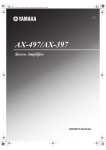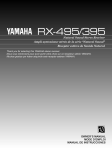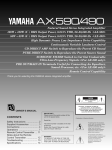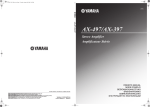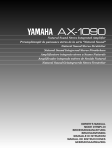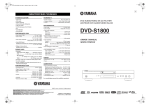Download Yamaha AVX-S30 Owner`s manual
Transcript
BAL HOME THEATER SOUND SYSTEM AVX-S30 (AVC-S30 + NX-S30 + NX-SW30) OWNER’S MANUAL CAUTION: READ THIS BEFORE OPERATING YOUR UNIT. 1 2 3 4 5 6 7 8 9 10 11 12 13 14 15 16 17 18 19 To assure the finest performance, please read this manual carefully. Keep it in a safe place for future reference. Install this sound system in a well ventilated, cool, dry, clean place with at least 10 cm on the top, 10 cm on the left and right, and 10 cm at the back of AVC-S30, and 20 cm on the top, 20 cm on the left and right, and 20 cm at the back of NX-SW30 — away from direct sunlight, heat sources, vibration, dust, moisture, and/ or cold. Locate this unit away from other electrical appliances, motors, or transformers to avoid humming sounds. Do not expose this unit to sudden temperature changes from cold to hot, and do not locate this unit in an environment with high humidity (i.e. a room with a humidifier) to prevent condensation inside this unit, which may cause an electrical shock, fire, damage to this unit, and/or personal injury. Avoid installing this unit where foreign object may fall onto this unit and/or this unit may be exposed to liquid dripping or splashing. On the top of this unit, do not place: – Other components, as they may cause damage and/or discoloration on the surface of this unit. – Burning objects (i.e. candles), as they may cause fire, damage to this unit, and/or personal injury. – Containers with liquid in them, as they may fall and liquid may cause electrical shock to the user and/or damage to this unit. Do not cover this unit with a newspaper, tablecloth, curtain, etc. in order not to obstruct heat radiation. If the temperature inside this unit rises, it may cause fire, damage to this unit, and/or personal injury. Do not plug in this unit to a wall outlet until all connections are complete. Do not operate this unit upside-down. It may overheat, possibly causing damage. Do not use force on switches, knobs and/or cords. When disconnecting the power cable from the wall outlet, grasp the plug; do not pull the cable. Do not clean this unit with chemical solvents; this might damage the finish. Use a clean, dry cloth. Only voltage specified on this unit must be used. Using this unit with a higher voltage than specified is dangerous and may cause fire, damage to this unit, and/or personal injury. YAMAHA will not be held responsible for any damage resulting from use of this unit with a voltage other than specified. Do not attempt to modify or fix this unit. Contact qualified YAMAHA service personnel when any service is needed. The cabinet should never be opened for any reasons. When not planning to use this unit for long periods of time (i.e. vacation), disconnect the AC power plug from the wall outlet. Be sure to read the “Troubleshooting” section on common operating errors before concluding that this unit is faulty. Before moving this unit, press STANDBY/ON to set this unit in standby mode, and disconnect the AC power plug from the wall outlet. Condensation will form when the surrounding temperature changes suddenly. Disconnect the power cable from the outlet, then leave the unit alone. When using the unit for a long time, the unit may become warm. Turn the power off, then leave the unit alone for cooling. Install this unit near the AC outlet and where the AC power plug can be reached easily. CAUTION This unit is not disconnected from the AC power source as long as it is connected to the wall outlet, even if this unit itself is turned off. This state is called the standby mode. In this state, this unit is designed to consume a very small quantity of power. The name plate is located on the bottom of the unit. (Bottom of AVC-S30) MODEL NO. AVC-S30 MADE IN MALAYSIA MODEL NO. AVC-S30 MADE IN MALAYSIA Name plate WARNING TO REDUCE THE RISK OF FIRE OR ELECTRIC SHOCK, DO NOT EXPOSE THIS APPLIANCE TO RAIN OR MOISTURE. ■ For U.K. customers If the socket outlets in the home are not suitable for the plug supplied with this appliance, it should be cut off and an appropriate 3 pin plug fitted. For details, refer to the instructions described below. Note The plug severed from the mains lead must be destroyed, as a plug with bared flexible cord is hazardous if engaged in a live socket outlet. ■ Special Instructions for U.K. Model IMPORTANT THE WIRES IN MAINS LEAD ARE COLOURED IN ACCORDANCE WITH THE FOLLOWING CODE: Blue: NEUTRAL Brown: LIVE As the colours of the wires in the mains lead of this apparatus may not correspond with the coloured markings identifying the terminals in your plug, proceed as follows: The wire which is coloured BLUE must be connected to the terminal which is marked with the letter N or coloured BLACK. The wire which is coloured BROWN must be connected to the terminal which is marked with the letter L or coloured RED. Making sure that neither core is connected to the earth terminal of the three pin plug. CONTENTS PREPARATION Supplied Parts ......................................................... 2 Controls and Functions .......................................... 3 Front panel ................................................................ 3 Remote control........................................................... 4 Placing the Speakers............................................... 6 CONFIGURATIONS Adjusting the Speaker Balance ............................15 Adjusting the speaker balance with test tones ........ 15 Adjusting the speaker balance during playback ..... 16 Adjusting the Orientation of the Virtual Surround Speakers............................................16 Placing the Satellite Speakers ................................... 7 Placing the subwoofer................................................ 7 Connecting the Speakers........................................ 8 Connecting External Components ........................ 9 Digital connection ..................................................... 9 Analog connection .................................................. 10 Using the Remote Control.................................... 11 Replacing the batteries ............................................ 11 OPERATION ADDITIONAL INFORMATION Status Indicator .....................................................18 Volume level ........................................................... 18 Input signal ............................................................. 18 Troubleshooting.....................................................19 Recommended Virtual Surround Speaker Settings ...............................................................20 Glossary..................................................................21 Specifications .......................................... back cover Basic Operation .................................................... 12 Enjoying Sounds with Specific Speaker Channels ............................................................ 13 Enjoying realistic sounds (CINEMA DSP) ............ 13 Enjoying stereo sounds with multi speaker channels (Dolby Pro Logic II) ............................ 13 Using the DVS function (Dolby Virtual Speaker) ..................................... 13 Enjoying Sounds in a Variety of Ways ............... 14 Listening with headphones (“SILENT CINEMA”) ....................................... 14 Listening at low volume (Night Listening) ............ 14 ■ Introduction The Yamaha Home Theater Sound System “AVX-S30” consists of the AV amplifier (AVC-S30), satellite speakers (NXS30) and subwoofer (NX-SW30). This product provides you with the best sound possible with simple operations, allowing you to enjoy various audio sources. We hope the “AVX-S30” brings you great listening pleasure and satisfaction. ■ About this manual • This manual provides information relevant only to the YAMAHA Home Theater Sound System “AVX-S30”. For information on the DVD player “DVD-S30”, refer to the “DVD-S30 OWNER’S MANUAL”. For information on other AV components, refer to the manual for that product. • In this manual, operations that can be performed using either the front panel buttons or remote control are explained using the remote control. • y indicates a tip for your operation. Notes contain important information about safety and operating instructions. • This manual is printed prior to production. Design and specifications are subject to change in part as a result of improvements, etc. In case of differences between the manual and the product, the product has priority. 1 PREPARATION PREPARATION Supplied Parts This product consists of the following parts. Before connecting speakers or a TV to this product, make sure you received all of the following parts. (The remote control is supplied with the DVD-S30.) AV amplifier (AVC-S30) x 1 Satellite speaker (NX-S30) x 2 Subwoofer (NX-SW30) x 1 Accessories System control cable (5 m) x 1 Amplifier stand x 2 Subwoofer cable (1-pin, 5 m) x 1 Non-skid pad (large) x 1 set (4 pieces) Speaker cable (for satellite, 5 m) x 2 Non-skid pad (small) x 2 sets (8 pieces) Owner’s Manual (this manual) BAL HOME THEATER SOUND SYSTEM AVX-S30 (AVC-S30 + NX-S30 + NX-SW30) OWNER’S MANUAL y You can place the amplifier vertically (STANDBY/ON becomes the top and VOLUME becomes the bottom as the diagram below) using the supplied amplifier stands. STANDBY/ON Amplifier stand 2 VOLUME PREPARATION Controls and Functions ■ Front panel 2 3 4 5 6 1 2 3 7 4 PREPARATION 1 8 VOLUME INPUT STANDBY/ON MOVIE NIGHT MUSIC qDigital 1 -8 GAME DTS 2 -6 SPORTS AUTO 3 -4 4 5 -2 0 q Pro Logic II MOVIE MUSIC 6 +2 MODE 7 +4 qVS 8 +6 9 +8 SILENT CINEMA 0 9 1 STANDBY/ON 6 Input indicator Turn this unit on or set it to the standby mode. Lights up the input number currently selected. y 7 VOLUME While the unit is in the standby mode, the unit consumes a small amount of power. Adjusts the overall volume level. 2 CINEMA DSP buttons 8 Remote control sensor Select CINEMA DSP programs. (page 13) Receives signals from the remote control. 3 CINEMA DSP indicator 9 Status indicator Lights up the icon for the CINEMA DSP program currently selected. (page 13) Shows the input signal type (page 18) or Dolby Pro Logic II mode (page 13) currently selected. Also, you can check the volume level (page 18) when adjusting it. 4 MODE Switches the Dolby Pro Logic II modes. (page 13) 5 INPUT 0 SILENT CINEMA jack Connects the headphones. (page 14) Selects an input source. 3 PREPARATION ■ Remote control You can control both the AV amplifier (AVC-S30) and DVD player (DVD-S30) with the supplied remote control. Read the following for the function of each button. (The buttons shaded in the illustration below are used to control the DVDS30. For details on DVD-S30 operations, refer to the “DVD-S30 OWNER’S MANUAL”.) 4 TV 1 5 TV INPUT* STANDBY/ON STANDBY/ON 2 DVD Switches the TV inputs. F ANGLE 3 4* 5* 6 * 7 8 9 0 A 1 2 3 SW CENTER SURR 5 6 7 8 REPEAT A-B AUDIO SUBTITLE 9 0 ZOOM SHIFT DUAL MONO qVS TV CH G H I J K L M SETUP ON SCREEN N MENU RETURN VOLUME O P MUTE B* Q NIGHT E * L R 1 2 INPUT 3 MODE MOVIE MUSIC 7 (Play) Starts disc playback on the DVD-S30. 8 (Pause) Pauses disc playback on the DVD-S30. 9 ON SCREEN Displays the On-Screen Menu on the TV screen while operating the DVD-S30. 0 ENTER TEST 6 TV CH +/–* Switches the TV channels. 4 TV INPUT TV TV VOL C D * Turns the TV on, or set it to the standby mode. R S , , , , ENTER Operates the On-Screen Menu or specify various parameters while operating the DVD-S30. Press to slow reverse and press to slow forward on the DVD-S30. , (Search) Fast forwards/fast reverses playback on the DVD-S30 with a specific speed. 4 SPORTS GAME To control your TV with these buttons, you need to set the appropriate remote control code. For details, refer to “DVDS30 OWNER’S MANUAL”. 1 Infrared signal transmitter A MENU Displays the DVD menu on the TV screen while playing back a DVD on the DVD-S30. Turns on/off the Playback Control menu on the TV screen while playing back a VCD on the DVD-S30. B TV VOLUME +/–* Adjusts the TV volume level. C TEST Outputs a test tone. (page 15) Sends signals to the units. 2 STANDBY/ON ( ) Turns the AVC-S30 on, or set it to the standby mode. y D MODE Switches between the Dolby Pro Logic II modes. (page 13) This unit consumes a small amount of power during the standby mode. E CINEMA DSP buttons 3 Number buttons (1 to 9, 0) F STANDBY/ON (DVD) Input numerals to specify parameters such as track or chapter numbers while operating the DVD-S30. Turns the DVD-S30 on, or set it to the standby mode. 4 Selects a CINEMA DSP program. (page 13) PREPARATION G SUBTITLE R NIGHT Selects the subtitle language of the DVD video while operating the DVD-S30. Turns on/off the Night Listening mode. (page 14) S INPUT buttons H AUDIO I SHIFT While holding down SHIFT, press a button below to enable the corresponding operation. Select an input source. L/R buttons While a test tone is output, press L to set the orientation of the virtual surround speaker (L), and press R to set the orientation of the virtual surround speaker (R). (page 16, 17) SW +/–: Adjusts the subwoofer channel volume. (page 16) CENTER +/–: Adjusts the center speaker channel volume. (page 16) SURR +/–: Adjusts the surround speaker channel volume. (page 16) ANGLE: Selects the disc viewing angle while operating the DVD-S30. ZOOM: Selects the zoom setting of the DVD while operating the DVD-S30. REPEAT: Enables the Repeat Play mode on the DVDS30. A–B: Enables the A-B Repeat mode on the DVD-S30. J qVS (Dolby Virtual Speaker) Turns on/off the DVS mode. (page 13) K DUAL MONO This button is not used for U.K., Australia, and Asia models. L , (Skip) Skips to the start of current track or next track while operating the DVD-S30. Press and hold to fast reverse or to fast forward disc playback on the DVD-S30. M (Stop) Stops disc playback on the DVD-S30. N SETUP Displays or closes the Setup menu on the TV while operating the DVD-S30. O RETURN Returns the DVD menu to the previous screen while operating the DVD-S30. P MUTE Turns off the volume. Q VOLUME +/– Adjusts the overall volume level. 5 PREPARATION Selects the audio language of the DVD video or the audio channel setting of the VCD and SVCD while operating the DVD-S30. PREPARATION Placing the Speakers To enjoy quality sounds thoroughly, you need to place the speakers in their appropriate positions and install them correctly. After deciding the speaker layout, follow the procedure below to install the speakers. Satellite speakers (L, R) (NX-S30) Satellite speaker (R) Satellite speaker (L) Place the left/right speakers on both sides of your TV at equal distances. We recommend that you place the speakers at the height of your ears at the listening position, and keep the speakers at least 80 cm (2’ 6”) apart while they are placed 80 cm (2’ 6”) away from the side walls. Main roles: Produces front channel (stereo) sounds. Also produces center channel sounds (dialogues or vocal sounds) and surround channel sounds effectively using the Yamaha Air Surround system. Subwoofer (NX-SW30) Place the subwoofer near a front speaker and turn it slightly toward the center of the room to reduce wall reflections. Main roles: Produces bass sounds and low frequency (LFE) sounds contained in Dolby Digital or DTS. Subwoofer Notes • Be sure to place the satellite speaker (L) on the left of the TV and the satellite speaker (R) on the left of the TV since the speakers are not symmetrical. Check the (L) and (R) marks printed on the back of each speaker to identify them. • To create better acoustic field, you need to place the satellite speakers properly and adjust the orientation of the virtual surround speakers suited for your listening environment. Also, the arrangement of furniture affects the acoustic field. For details, refer to “Adjusting the Orientation of the Virtual Surround Speakers” (page 16). • If the speakers interfere with TV reception, noises may appear on the TV screen. In such a case, move the speakers a little away from the TV. • Bass sounds produced by the subwoofer may be heard differently depending on the listening position and subwoofer location. To enjoy desired sounds, try to change the location of the subwoofer according to the listening position. 6 PREPARATION ■ Placing the Satellite Speakers You can place the satellite speakers on a rack, or attach them to a wall. Please select an installation method that suits your room layout. y To place on a rack Non-skid pad (small) Attach the non-skid pads (small) to the bottom of each speaker, and then place them on level hard surfaces. y Using non-skid pads prevents the speakers from sliding when they vibrate, and ensures quality sound production. To attach to a wall 198 mm (7-25/32”) Diameter of 3.5 to 4 mm (1/8” to 5/32”) 20 mm (25/32”) or more You can attach the speakers to a wall using commercially available screws (Diameter: 3.5 to 4 mm (1/8” to 5/32”), Length: 24 mm (15/16”) or more). One speaker requires two screws. 1 Install two screws in the wall where you want to place the speaker. 2 Hang the speaker on the screws using the holes in the back of the speaker. 4 mm (5/32”) 198 mm (7-25/32”) Notes • One speaker weighs about 1.4 kg (3 lbs 3 oz). To attach a speaker to a wall using screws, the wall must be firm. Do not attach a speaker to a wall that is made of weak materials such as plaster or veneered woods. Doing so may cause the speaker to fall. • Make sure you use specified screws to attach a speaker to a wall. Using clamps other than specified screws, such as short screws, nails, or two-sided tape, may cause the speaker to fall. • When connecting the speakers, fix the speaker cables in place so that cables do not loosen. If your foot or hand accidentally gets caught on a loose speaker cable, the speaker may fall. • After attaching each speaker, check that the speaker is fixed securely. YAMAHA will bear no responsibility for any accidents caused by improper installations. ■ Placing the subwoofer Attach the non-skid pads (large) to the bottom of the subwoofer, and then place the subwoofer on a level hard floor. y Using non-skid pads prevents the subwoofer from sliding when it vibrates, and ensures quality sound production. Non-skid pad (large) 7 PREPARATION You can attach the satellite speaker to a commercially available speaker bracket or speaker stand using the screw holes on the bottom of the speakers. In this case, be sure to use 6M (diameter of 6 mm) screws. PREPARATION Connecting the Speakers Follow the procedure below to connect the satellite speakers (NX-S30) and subwoofer (NX-SW30) to the AV amplifier (AVC-S30). Notes • Do not connect the power cables of the AV amplifier and subwoofer until all cable connections are completed. • Do not use excessive force when inserting the cable plug. Doing so may damage the cable plug or speaker jack. Connect the cable plugs to the speaker jack of the same color until you hear a click. White: Insert the cable plug facing the tub upwards. Red: Insert the cable plug facing the tub downwards. SP L Tab Satellite speaker (L) EA KE RS R SP EA KE R IM PE DA NC E: 6 Satellite cable (supplied, white plug) ΩM IN . AV amplifier INPUT 4 1 2 3 SPEAKERS L L R R To AC outlet SPEAKER IMPEDANCE:6ΩMIN. SYSTEM CONNECTOR OUT SUBWOOFER System control cable (supplied) Satellite cable (supplied, red plug) Subwoofer cable (supplied) SYSTEM INPUT CONNECTOR Satellite speaker (R) To AC outlet Subwoofer 8 PREPARATION Connecting External Components The AV amplifier “AVC-S30” has four input jacks (optical digital x 2, coaxial digital x 1, analog x 1). Before connecting your external components to the AV amplifier, check the output jacks of the components and be sure to use correct connection cables. PREPARATION ■ Digital connection Notes • Do not connect the power cables of the AV amplifier and external components until all cable connections are completed. • The digital terminals of this unit support PCM, Dolby Digital, DTS signal system. • The digital terminals support digital signals of which sampling frequency is 96 kHz or less. TV (monitor) CD player with coaxial digital output DVD player (DVD-S30) DIGITAL OUT (OPTICAL) s COAXIAL DIGITAL OUTPUT p e VIDEO INPUT Video pin cable (supplied with DVD-S30) VIDEO OUT (VIDEO) Optical cable (supplied with DVD-S30) To AC outlet INPUT 4 1 2 3 Coaxial cable (commercially available) SPEAKERS L L R R SPEAKER IMPEDANCE:6ΩMIN. SYSTEM CONNECTOR OUT SUBWOOFER Optical cable (commercially available) Video pin cable (commercially available) About optical cables 14 mm Use an optical cable with the plug of 14 mm or less (shown above). OPTICAL DIGITAL OUTPUT VIDEO OUTPUT VIDEO INPUT TV game console etc. TV (monitor) 9 PREPARATION ■ Analog connection Note Do not connect the power cables of the AV amplifier and external components until all cable connections are completed. TV (monitor) VIDEO INPUT Video pin cable (commercially available) To AC outlet VCR etc. (L) INPUT 4 1 2 3 R R AUDIO OUTPUT (R) SPEAKER IMPEDANCE:6ΩMIN. (R) SYSTEM CONNECTOR OUT SUBWOOFER R VIDEO OUTPUT L (L) Audio pin cable (commercially available) (R) Video camera or TV game console etc. with no digital output (R) (L) Audio pin cable (commercially available) (L) TV R L AUDIO OUTPUT Connect the TV to the AV amplifier to enjoy TV sounds on the system. 10 SPEAKERS L L PREPARATION Using the Remote Control Use the remote control within 6 m (20 feet) of the AV amplifier and point it toward the remote control sensor. 2 3 4 Notes VOLUME INPUT MOVIE NIGHT MUSIC qDigital 1 -8 GAME DTS 2 -6 SPORTS AUTO 3 -4 4 -2 5 0 q Pro Logic II MOVIE MUSIC 6 +2 MODE 7 +4 Within 6 m (20 feet) qVS 8 +6 9 +8 SILENT CINEMA 30˚ 30˚ • Be careful not to spill liquid on the remote control. • Be careful not to drop the remote control. • Do not leave the remote control in the following places: – hot or humid places, such as near a heater or in a bathroom – extremely cold places – dusty places ■ Replacing the batteries If the batteries grow old, the effective operation distance of the remote control decreases considerably. If this happens, replace the batteries with two new ones as soon as possible. 1 Press the mark on the battery cover and slide off the cover. 2 Insert the two new batteries (AA, R06, UM-3) into the battery compartment. Make sure you insert the batteries according to the polarity markings (+ and –). 3 Close the battery cover. Press Notes • Do not use an old battery together with new one. • Do not use different types of batteries (for example, alkaline and manganese) together. Each type of battery has its own characteristics even if they are similar in shape. • If the batteries run out, immediately remove them from the remote control to prevent an explosion or acid leak. • Dispose of the batteries according to the regional regulations. • If a battery starts leaking, dispose of it immediately. Be careful not to let leaking battery acid come into contact with your skin or clothing. Before inserting new batteries, wipe the compartment clean. • Replace the batteries within two minutes to preserve the memory in the remote control. 11 PREPARATION 1 STANDBY/ON OPERATION OPERATION Basic Operation Once you have finished all cable connections (pages 8-10) and remote control preparation (page 11), follow the procedure below to start from basic playback operation. 1 STANDBY/ON STANDBY/ON STANDBY/ON ( ) Press STANDBY/ON ( ). This unit turns on and the indicators on the front panel light up. y DVD This unit has the auto-sleep function which automatically switches to the standby mode if you do not operate the unit for about 24 hours while the unit is turned on. ANGLE 1 2 3 SW CENTER SURR 4 ZOOM 5 6 7 8 REPEAT A-B AUDIO SUBTITLE 9 0 SHIFT TV INPUT TV 2 Press one of the INPUT buttons (1 to 4) to select an input source. For example, if the DVD-S30 is connected to the INPUT (1) jack on the rear panel of this unit, press INPUT (1) to select the DVD-S30. 3 Start playback on the selected external component. For information on the external component, refer to the manual for that product. 4 Press VOLUME +/– to adjust the volume level. DUAL MONO qVS TV CH ON SCREEN SETUP ENTER MENU RETURN VOLUME TV VOL MUTE VOLUME +/– NIGHT MUTE TEST L R 1 2 INPUT 3 MODE MOVIE MUSIC 4 SPORTS GAME INPUT buttons y To turn off the volume temporarily, press MUTE. While the mute function is on, the Input indicators (other than one currently selected) blink. To disable the mute function, press MUTE once again. Now, please try various features of this unit! To enjoy high realistic sensational sounds with a DSP program → “Enjoying realistic sounds (CINEMA DSP)” (page 13) To enjoy stereo sounds such as CD audio with virtual multi channels → “Enjoying stereo sounds with multi speaker channels (Dolby Pro Logic II)” (page 13) To enjoy virtual surround sounds with the DVS function → “Using the DVS function (Dolby Virtual Speaker)” (page 13) To configure the orientation of virtual surround speakers → “Adjusting the Orientation of the Virtual Surround Speakers” (page 16) 12 OPERATION Enjoying Sounds with Specific Speaker Channels The sound program features allow you to enjoy various kinds of audio such as movie or music. Please choose a program based on your listening preference, and not purely on the name of the program. y This unit automatically memorizes the settings assigned to each input (1 to 4). If you select another input, the unit automatically recalls the last settings for the selected input. TV INPUT TV DUAL MONO qVS qVS TV CH ENTER MENU The Dolby Pro Logic II modes reproduce 5.1-channel audio from the stereo sounds. Press MODE repeatedly to select the desired Dolby Pro Logic mode. Each time you press the button, the mode changes as follows. SETUP ON SCREEN ■ Enjoying stereo sounds with multi speaker channels (Dolby Pro Logic II) RETURN q Pro Logic II MOVIE MUSIC AUTO VOLUME TV VOL OPERATION SHIFT MUTE 6 7 8 AUTO (q Pro Logic II Off) NIGHT TEST L 2 AUTO INPUT MODE 3 MODE MOVIE MUSIC q Pro Logic II MOVIE MUSIC R 1 6 4 SPORTS 7 8 q Pro Logic II MOVIE GAME CINEMA DSP buttons q Pro Logic II MOVIE MUSIC AUTO 6 7 8 q Pro Logic II MUSIC ■ Enjoying realistic sounds (CINEMA DSP) The CINEMA DSP programs reproduce realistic sounds with the multi speaker channels. Press one of the CINEMA DSP buttons. The icon for the selected CINEMA DSP program lights up. The characteristics of each CINEMA DSP program are as follows. Movie Produces the rich acoustical presence of a movie theater. Music Magnifies the feeling of listening to live rock or jazz in a concert hall. Sports program In a live stereo sports broadcast, announcer voices are central, engulfed in the cheers and emotional whirl of the stadium. Game program Gives TV games extra depth and surround. To reproduce the original sounds, press the CINEMA DSP button currently selected or MODE. ■ Using the DVS function (Dolby Virtual Speaker) The Dolby Virtual Speaker (DVS) function reproduces 5.1-channel-like realistic sensational sounds with the front and subwoofer channels only. Press qVS. The Status indicator (qVS) lights up. To disable the DVS function, press qVS once again. qVS qVS 9 9 y • Activating the DVS function automatically cancels the CINEMA DSP program currently selected. Also, you cannot select a CINEMA DSP program while the DVS function is activated. To select a CINEMA DSP program, press qVS to disable the DVS function. • Activating the DVS function while a stereo signal is input automatically selects the Dolby Pro Logic II Movie mode. • When a Mono or Dual Mono signal is input, the DVS function is not available. • When headphones are connected to the SILENT CINEMA jack on the unit, the DVS function is not available. 13 OPERATION Enjoying Sounds in a Variety of Ways You can enjoy the presence of sound effects even when you use headphones or reduce the volume level. 1 2 3 ■ Listening at low volume (Night Listening) VOLUME 4 INPUT STANDBY/ON MOVIE MUSIC SPORTS GAME The Night Listening function tones down large sound effect and clears speech or vocal sounds. MODE q Pro Logic II NIGHT qDigital 1 -8 DTS 2 -6 AUTO 3 -4 4 -2 5 0 MOVIE 6 MUSIC 7 +2 +4 qVS 8 +6 9 +8 SILENT CINEMA 1 SILENT CINEMA jack Press NIGHT. The Status indicator (NIGHT) lights up. NIGHT NIGHT 1 1 VOLUME TV VOL MUTE 2 NIGHT TEST L R 1 2 INPUT 3 MODE MOVIE MUSIC 4 SPORTS NIGHT INPUT buttons GAME CINEMA DSP buttons ■ Listening with headphones (“SILENT CINEMA”) “SILENT CINEMA” allows you to enjoy multi-speaker simulation sounds with headphones. * “SILENT CINEMA” is a registered trademark of YAMAHA CORPORATION. 1 Connect the headphones to the CINEMA jack on the unit. 2 Press the INPUT button for the desired input source, then start playback on the external component. 3 As needed, press the CINEMA DSP button for the desired CINEMA DSP program. SILENT y • Low frequency sounds (LFE signals) are mixed with other channel audio. • If you do not select a CINEMA DSP program when a stereo signal is input, the headphone produces normal stereo sound. • When headphones are connected to the SILENT CINEMA jack, the speakers do not output any sounds. • When headphones are connected to the SILENT CINEMA jack on the unit, the DVS function is not available. 14 Press the INPUT button for the desired input source, then start playback on the external component. To disable the Night Listening function, press NIGHT once again. y • If you activate a CINEMA DSP program or the DVS function with the Night Listening function, you can enjoy realistic sensational sounds at low volume. • When headphones are connected to the SILENT CINEMA jack on the unit, the Night Listening functions is not available. CONFIGURATIONS CONFIGURATIONS Adjusting the Speaker Balance The initial speaker settings are suitable for most conditions. However, depending on room conditions or listening position, you may need to adjust the speaker balance manually. In this case, adjust the speaker balance using test tones at first. CONFIGURATIONS y • When headphones are connected to the SILENT CINEMA jack on the unit, the adjustment is not available. • Adjust the speaker balance at your listening position with the remote control. ■ Adjusting the speaker balance with test tones ON SCREEN SETUP ENTER MENU Front (L) RETURN VOLUME TV VOL MUTE Subwoofer VOLUME +/– Front (R) Center NIGHT TEST L TEST R 1 2 INPUT 3 MODE MOVIE MUSIC 4 SPORTS Surround (L) GAME Surround (R) : Satellite speaker and subwoofer 1 Press TEST. The CINEMA DSP indicators blink and each speaker outputs the test tone for about 2.5 seconds in order. 2 While a test tone is output from the speaker channel you want to adjust, press VOLUME +/– to adjust the volume level of the currently selected speaker channel. : Virtual speaker 3 To confirm the adjustment, press TEST. y • You can check the volume level in detail with the Status indicator (page 18). • While adjusting the volume level of a speaker, other speakers do not output test tones. • The adjustable range for the volume level of each speaker channel is as follows. – Front (L, R): –6 (Min) to ±0 dB (Max) – Center: –4 (Min) to + 4 dB (Max) – Surround (L, R): –4 (Min) to +4 dB (Max) – Subwoofer: –8 (Min) to +8 dB (Max) • You cannot adjust the volume level of the center speaker channel and surround speaker channels while the DVS function is activated. • To reset the volume level of all speaker channels to the factory settings, press INPUT on the front panel while a test tone is output. (This procedure also resets the orientations of the virtual surround speakers.) 15 CONFIGURATIONS ■ Adjusting the speaker balance during playback If you feel the speaker balance is not proper during playback, follow the procedure below. STANDBY/ON STANDBY/ON DVD CENTER +/– SW +/– ANGLE 1 2 3 SW CENTER SURR 5 6 7 REPEAT A-B AUDIO 9 0 4 ZOOM SURR +/– 8 SUBTITLE SHIFT TV SHIFT TV INPUT DUAL MONO TV CH qVS SETUP ON SCREEN ENTER MENU RETURN During playback, carry out the following operation for your purpose. To adjust the volume level of the center speaker channel: While holding down SHIFT, press CENTER +/–. To adjust the volume level of the surround speaker channels: While holding down SHIFT, press SURR +/–. Adjusting the Orientation of the Virtual Surround Speakers This unit employs the Yamaha Air Surround system that enables the surround sound field using six speaker units built in two satellite speakers. To create better acoustic field, please adjust the orientation of the virtual surround speakers suited for your listening environment. You can select from five presets for each satellite speaker (L and R). Note To create better acoustic field, you may need to change the arrangement of the satellite speakers or furniture. For example, the Air Surround system does not work well (or does not work at all) in the following situations. – The satellite speakers are placed inside the rack. – The satellite speakers are not placed perpendicular to the side walls. – There is an obstacle at the front (or diagonally in front) of satellite speakers. – A piece of furniture is placed at the reflection points (A, B). – There are no reflection faces (walls or windows). y • You cannot adjust the orientation of the virtual surround speakers while the DVS function is activated. To adjust it, press qVS to disable the DVS function. • When headphones are connected to the SILENT CINEMA jack on the unit, the adjustment is not available. ON SCREEN To adjust the volume level of the subwoofer channel: While holding down SHIFT, press SW +/–. SETUP ENTER MENU RETURN VOLUME TV VOL MUTE y • We recommend that you first adjust the speaker balance with test tones (page 15). • You can check the volume level in detail with the Status indicator (page 18). • The adjustable range for the volume level of each speaker channel is as follows. – Center: –4 (Min) to + 4 dB (Max) – Surround: –4 (Min) to +4 dB (Max) – Subwoofer: –8 (Min) to +8 dB (Max) • You cannot adjust the left and right surround speakers individually with this procedure. To adjust them individually, carry out the “Adjusting the speaker balance with test tones” procedure (page 15). 16 NIGHT TEST L TEST R 1 2 L/R INPUT 3 MODE MOVIE MUSIC 4 SPORTS GAME 1 Press TEST. Each speaker outputs the test tone for about 2.5 seconds in order. 2 Press L once to check the current orientation of the virtual left surround speaker, or press R once to check the current orientation of the virtual right surround speaker. The Status indicator blinks to show the current orientation for about 2.5 seconds. By the factory setting, “40°” is selected for each speaker. CONFIGURATIONS 3 While the Status indicator is blinking, press L repeatedly to select an orientation of the virtual left surround speaker, or press R repeatedly to select an orientation of the virtual right surround speaker. Each time you press the button, the orientation changes as follows. Satellite speaker (L) Press L to adjust Press R to adjust A A 30° (Four status indicators from the right or left light up) B Satellite speaker (L) 40° (Three status indicators from the right or left light up) Satellite speaker (R) Press R to adjust A A B y Adjust the angle so that the first reflection point (A) is located posterior to the listening position and surround speaker channel audio reaches the listening position after reflections as shown below. For information on the recommended listening environment and virtual surround speaker settings, refer to “Recommended Virtual Surround Speaker Settings” (page 20). B Press L to adjust 60° (Rightmost or leftmost status indicator lights up) 4 CONFIGURATIONS 20° (Five status indicators from the right or left light up) 50° (Two status indicators from the right or left light up) Satellite speaker (R) B To confirm the adjustment, press TEST. y To reset the orientations to the factory settings, press INPUT on the front panel while a test tone is output. (This procedure also resets the speaker balance.) 17 ADDITIONAL INFORMATION ADDITIONAL INFORMATION Status Indicator You can check the volume level or audio input signal types on the Status indicator. ■ Volume level Volume level of each speaker channel (difference based on the system volume, unit: dB) Status indicator (green) 1 1 -8 2 -8 2 -6 2 -6 -6 3 3 -4 3 -4 -4 4 4 -2 4 -2 -2 5 0 5 0 Front (L, R) –6 –5 –4 –3 –2 –1.5 –1 –0.5 ±0 Center, Surround (L, R) –4 –3.5 –3 –2.5 –2 –1.5 –1 –0.5 ±0 Subwoofer –8 –7 –6 –5 –4 –3 –2 –1 ±0 Status indicator (green) 6 5 6 +2 0 6 +2 +2 7 +4 7 +4 7 +4 8 +6 8 +6 8 +6 9 +8 9 +8 Front (L, R) – – – – – – – – Center, Surround (L, R) +0.5 +1 +1.5 +2 +2.5 +3 +3.5 +4 Subwoofer +1 +2 +3 +4 +5 +6 +7 +8 ■ Input signal This unit automatically handles input signals. You cannot switch the signal type manually. For details on each signal type, refer to “Glossary” (page 21). qDigital DTS 2 qDigital 2 4 5 3 4 5 3 4 5 DTS 2 qDigital AUTO 3 6 When a Dolby Digital signal is input 6 When a DTS signal is input AUTO DTS AUTO 6 When an analog signal or PCM signal is input y The status indicator “AUTO” turns off when one of the CINEMA DSP programs or Dolby Pro Logic modes is selected. 18 ADDITIONAL INFORMATION Troubleshooting If there is any problem with this unit, check the following items. If you cannot solve your problem with the following remedies or if your problem is not listed below, turn off and unplug this unit, then consult the nearest authorized YAMAHA dealer or service center. Problem Power turns on but immediately shuts off Solution Make sure the power cable is plugged into the outlet firmly. The speaker cable may be shorted. Make sure all speaker cables are connected properly. This unit may receive a strong electrical shock such as from a lightening bolt or excessive static electricity. Set this unit to the Standby mode, then disconnect the power cable. Wait for about 30 seconds, then connect the power cable and turn on this unit. The volume may be set to minimum level. Adjust the volume level. (page 12) The Mute function may be enabled. Cancel the Mute function. (page 12) The input source or input setting may be incorrect. Select the correct input source or input setting. (page 12) The cables may be connected improperly. Make sure all cables are connected properly. (pages 8-10) Sound is too low on one side The cables may be connected improperly. Make sure all cables are connected properly. (pages 8-10) Speaker channels other than the front ones make no sound You may be listening to stereo sounds without the sound field effect. Press CINEMA DSP to enable the sound field effect. (page 13) You may be listening to an audio source (Dolby Digital or DTS) that does not contain any special effect signal. Select another sound field program. (page 13) The volume of the center speaker channel may be set to minimum level. Adjust the volume level of the center speaker channel using test tones. (page 15) You may be listening to a Dolby Digital or DTS audio source. Dolby Digital and DTS audio sources do not contain a center speaker signal. The surround speaker channels make no sound The volume of the surround speaker channels may be set to minimum level. Adjust the volume level of the surround speaker channels using test tones. (page 15) The subwoofer makes no sound The volume of the subwoofer may be set to Adjust the volume level of the subwoofer. minimum level. (page 15) The center speaker channel makes no sound The subwoofer cable or system control cable may be connected improperly. Make sure all cables are connected properly. (page 8) You may be listening to an audio source that The subwoofer does not support signals does not contain any low tone signal. outside the specified range. Sound is poor (noisy) The speaker cable may be shorted. Make sure all cables are connected properly. (pages 8-10) This unit does not operate properly This unit may receive a strong electrical shock, such as from a lightening bolt or excessive static electricity, or drop in power supply. Set this unit to the Standby mode, then disconnect the power cable. Wait for about 30 seconds, then connect the power cable and turn on this unit. A digital or high-frequency equipment produces noises This unit may be placed close to the digital equipment or high-frequency equipment. Place this unit further away from such equipment. The remote control does not work This unit may be operated outside the for operating this unit remote control operation range. For information on the remote control operation range, refer to “Using the Remote Control” (page 11). The remote control sensor on this unit may be exposed to direct sunlight or lighting. Change the lighting or this unit’s orientation. The batteries may be worn out. Replace the batteries. (page 11) 19 ADDITIONAL INFORMATION The speakers make no sound Cause The power cable may be connected improperly. ADDITIONAL INFORMATION Recommended Virtual Surround Speaker Settings If you cannot adjust the orientation of the virtual surround speakers well (page 16), use the following information for reference. Note To create better acoustic field, you may need to change the arrangement of the satellite speakers or furniture. Satellite speaker (L) Satellite speaker (R) TV 0.6 m (2.0 ft) 3 1.1 m (3.6 ft) 4 5 1 0.7 m (2.3 ft) 2 Room size: (Length 1 × Width 2) Distance of satellite speakers and side walls: 3 and 4 Distance of satellite speakers and listening position: 5 Recommended setting 2.7 m × 2.7 m (8.8 ft × 8.8 ft) 0.8 m (2.6 ft) 0.8 m (2.6 ft) 0.8 m (2.6 ft) 0.8 m (2.6 ft) 1.2 m (3.9 ft) 1.6 m (5.2 ft) 0.8 m (2.6 ft) 1.2 m (3.9 ft) 1.6 m (5.2 ft) 0.8 m (2.6 ft) 1.2 m (3.9 ft) 1.6 m (5.2 ft) 0.8 m (2.6 ft) 1.2 m (3.9 ft) 1.6 m (5.2 ft) 2.0 m (6.6 ft) 1.4 m (4.6 ft) 1.4 m (4.6 ft) 2.2 m (7.2 ft) 1.4 m (4.6 ft) 1.4 m (4.6 ft) 1.3 m (4.3 ft) 2.2 m (7.2 ft) 2.1 m (6.9 ft) 1.9 m (6.2 ft) 2.2 m (7.2 ft) 2.1 m (6.9 ft) 1.9 m (6.2 ft) 2.2 m (7.2 ft) 2.1 m (6.9 ft) 1.9 m (6.2 ft) 1.7 m (5.6 ft) 30° 30° 20° 30° 40° 50° 20° 30° 40° 20° 30° 40° 20° 30° 40° 50° 3.6 m × 2.7 m (11.8 ft × 8.8 ft) 2.7 m × 3.6 m (8.8 ft × 11.8 ft) 3.6 m × 3.6 m (11.8 ft × 11.8 ft) 3.6 m × 4.5 m (11.8 ft × 14.8 ft) 4.5 m × 3.6 m (14.8 ft × 11.8 ft) 20 ADDITIONAL INFORMATION Glossary ■ Dolby Pro Logic II Front surround sound system which is developed by Yamaha enables the surround sound field using six speaker units built in two satellite speakers. In comparison with traditional front surround technologies, the Air Surround system enables a wide range of natural surround sound field. It is an improved matrix decoding technology that provides better spatiality and directionality on Dolby Surround programmed material; provides a convincing three-dimensional sound field on conventional stereo music recordings; and is ideally suited to bring the surround experience to automotive sound. While conventional surround programming is fully compatible with Dolby Surround Pro Logic II decoders, soundtracks will be able to be encoded specifically to take full advantage of Pro Logic II playback, including separate left and right surround channels. (Such material is also compatible with conventional Pro Logic decoders). ■ Channel (ch) A channel is an audio type that has been divided based on range and other characteristics. Ex. 5.1 channel • Front speakers, Left (1ch), Right (1ch) • Center speaker (1 ch) • Surround speakers, Left (1ch), Right (1ch) • Subwoofer (1 ch x 0.1* = 0.1 ch) * In contrast to a full 1-channel band, a component designed to enhance low frequency sound for added effect. ■ CINEMA DSP (Digital Sound Field Processor) ■ DTS (Digital Theater System) Digital surround sound system developed by Digital Theater Systems, Inc., which provides 5.1 channel audio. With an abundance of audio data, it is able to provide authentic-sounding effects. ■ DVS (Dolby Virtual Speaker) Since the Dolby Surround and DTS systems were originally designed for use in movie theaters, their effect is best felt in a theater having many speakers and designed for acoustic effects. Since home conditions, such as room size, wall material, number of speakers, and so on, can differ so widely, it’s inevitable that there are differences in the sound heard as well. Based on a wealth of actually measured data, YAMAHA CINEMA DSP uses YAMAHA original sound field technology to combine Dolby Pro Logic, Dolby Digital and DTS systems to provide the visual and audio experience of movie theater in the listening room of your own home. Front surround sound system which is developed by Dolby Laboratories provides 5.1-channel audio. ■ Dolby Digital The number of sampling (process for digitalizing analog signals) per second. In principle, the higher the sampling rate, the wider the frequency range that can be played back, and the higher the quantized bit rate, the finer the sound that can be reproduced. Digital surround sound system which is developed by Dolby Laboratories provides completely independent multi-channel audio. With 3 front channels (left, center, and right) and 2 surround stereo channels, Dolby Digital provides five full-range audio channels. With an additional channel especially for bass effects (called LFE, or low frequency effect), the system has a total of 5.1-channels (LFE is counted as 0.1 channel). By using 2-channel stereo for the surround speakers, more accurate moving sound effects and surround sound environment are possible than with Dolby Surround. ■ PCM (Pulse Code Modulation) A signal that is changed to digital format without compression. A CD is recorded with 16-bit sound at 44.1 kHz, while DVD recording is anywhere from 16 bits at 48 kHz to 24 bits at 192 kHz, which makes it a higher quality sound than CD. This signal also has a type called Packed PCM (PPCM) that can be compressed without any loss of data. ■ Sampling frequency ■ “SILENT CINEMA” “SILENT CINEMA” was developed by YAMAHA as a natural, realistic sound effect DSP algorithm for headphones. Parameters for headphones have been set for each sound field so that accurate representations of all the sound field programs can be enjoyed on headphones. 21 ADDITIONAL INFORMATION ■ Air Surround Specifications Amplifier Subwoofer • Model name.........................................................................AVC-S30 • Min RMS output power................ 30 W × 6 (1 kHz, 6 Ω , 1% THD) • Max power Front L/R............................................. 35 W × 6 (6 Ω , 10% THD) • Input sensitivity (analog)....................................................... 200 mV • Phones output/impedance...................125 mV/8 Ω (1 kHz, 200 mV) • Power supply Australia model ....................................................AC 240 V, 50 Hz Taiwan model ............................................... AC 110-120 V, 60 Hz Korea model .........................................................AC 220 V, 60 Hz U.K. and Asia models ..........................................AC 230 V, 50 Hz • Power consumption Taiwan model ......................................................................... 44 W Other models .......................................................................... 35 W • Standby power consumption ......................................... 0.4 W or less • Dimensions (W × H × D) ....................................215 × 70 × 305 mm (Approx. 8 15/32” × 2 3/4 × 12”) • Weight ...................................................................................... 2.6 kg (Approx. 5 lbs 12 oz) • • • • • • Model name .......................................................................NX-SW30 Type ...........Advanced YAMAHA Active Servo Technology System Driver...........................16 cm (6 1/2”) cone magnetic shielding type Input impedance .......................................................................12 kΩ Output power .................................... 50 W (100 Hz, 5Ω, 10% THD) Power supply U.K. model .......................................................... AC 230 V, 50 Hz Australia model ................................................... AC 240 V, 50 Hz Korea model......................................................... AC 220 V, 60 Hz Taiwan model........................................... AC 110-120 V, 50/60 Hz Asia model............................................... AC 220-240 V, 50/60 Hz • Power consumption ................................................................... 40 W • Dimensions (W × H × D) ..................................280 x 325 x 289 mm (Approx. 11 1/32” × 12 13/16” × 11 3/8”) • Weight.......................................................................................8.2 kg (Approx. 17 lbs 10 oz) Satellite speaker • • • • • Model name...........................................................................NX-S30 Type............ Full range acoustic suspension magnetic shielding type Driver ............................ 5 cm (2”) cone magnetic shielding type × 3 Input impedance ........................................................................... 6 Ω Dimensions (W × H × D) ....................................240 × 80 × 105 mm (Approx. 9 1/2” × 3 3/16” × 4 5/32”) • Weight ...................................................................................... 1.4 kg (Approx. 3 lbs 3 oz) “SILENT CINEMA” is a trademark of YAMAHA CORPORATION. The AV amplifier (AVC-S30) employs Yamaha Air Surround system which enables the surround sound field using six speaker units built in two satellite speakers. QD-Bass Technology QD-Bass (Quatre Dispersion Bass) technology uses square, pyramid-shaped reflective plates to radiate the sound in four horizontal directions. VIRTUAL SPEAKER Manufactured under license from Dolby Laboratories. “Dolby”, “Pro Logic” and the double-D symbol are trademarks of Dolby Laboratories. The subwoofer (NX-SW30) employs Advanced Yamaha Active Servo Technology which YAMAHA has developed for reproducing higher quality super-bass sound. “DTS” and “DTS Digital Surround” are registered trademarks of Digital Theater Systems, Inc. © 2005 YAMAHA ELECTRONICS CORPORATION, USA 6660 ORANGETHORPE AVE., BUENA PARK, CALIF. 90620, U.S.A. YAMAHA CANADA MUSIC LTD. 135 MILNER AVE., SCARBOROUGH, ONTARIO M1S 3R1, CANADA YAMAHA ELECTRONIK EUROPA G.m.b.H. SIEMENSSTR. 22-34, 25462 RELLINGEN BEI HAMBURG, GERMANY YAMAHA ELECTRONIQUE FRANCE S.A. RUE AMBROISE CROIZAT BP70 CROISSY-BEAUBOURG 77312 MARNE-LA-VALLEE CEDEX02, FRANCE YAMAHA ELECTRONICS (UK) LTD. YAMAHA HOUSE, 200 RICKMANSWORTH ROAD WATFORD, HERTS WD18 7GQ, ENGLAND YAMAHA SCANDINAVIA A.B. J A WETTERGRENS GATA 1, BOX 30053, 400 43 VÄSTRA FRÖLUNDA, SWEDEN YAMAHA MUSIC AUSTRALIA PTY, LTD. 17-33 MARKET ST., SOUTH MELBOURNE, 3205 VIC., AUSTRALIA All rights reserved. Printed in Malaysia WF66610




























